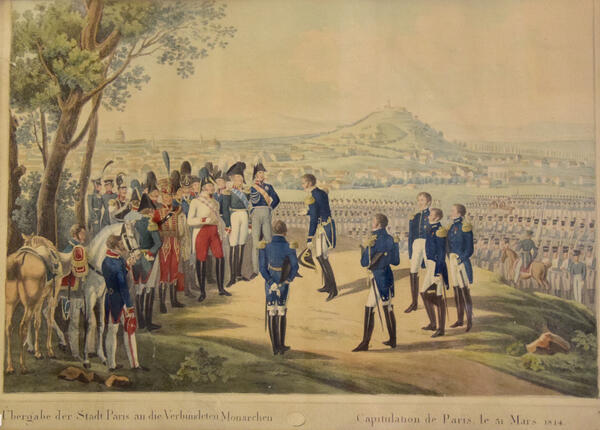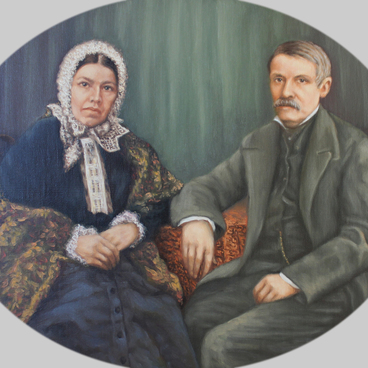This work of an unknown author tells about this historical event in the last days of March 1814 - the surrender of Paris. The author saw it as taking place on a bright, sunny day. On the left, under the shade of the trees, stand Russian officers, generals, emperors of the allied forces, headed by Emperor Alexander I. On the right are a group of French officers in blue uniforms, without head ware of any kind. In the background, rows of allied forces are lined up. Beyond them a panoramic view of Paris is depicted.
The plot is based on the last battle of the Napoleonic Wars era on March 18 (30), 1814. At that time the allied troops, the bulk of which were Russian soldiers, rushed to take Paris before Napoleon approached. The allies were led by Field Marshals Blucher and Schwarzenberg. Meanwhile, Napoleon’s forces were tied up in the south of France. It was here the French emperor hoped to liberate the French garrisons and strengthen his army.
A series of fierce skirmishes brought to the very gates of Paris. Marshal Marmont, who commanded one of the flanks of Paris’s defense, sent negotiators to Russian Emperor Alexander I. These negotiations dragged on until late that night. Alexander I posed the only condition under which he would withdraw his forces: Paris had to surrender. In the distance, Montmartre rises above the outskirts of Paris. It was from this mountain that formal defense commander Joseph Napoleon watched the enemy forces. He decided to leave the battlefield, leaving Marmont and Mortier the authority to surrender Paris in order to save the city.
In the battle over Paris, Russian forces lost over six thousand soldiers. Conquering the city became one of the bloodiest fights for the allies. Paris surrendered on March 31, 1814. Napoleon’s troops fled the city as the Russian army, led by Emperor Alexander I, triumphantly entered the French capital. For the first time since the Hundred Years War, foreign troops entered Paris. On April 4th, under pressure from his marshals, emperor Napoleon abdicated the throne.
A graphic sheet depicting the surrender of Paris was donated to the museum in 1972. Then it was given to Yalutorovsk by the State Historical Museum in Moscow.
The plot is based on the last battle of the Napoleonic Wars era on March 18 (30), 1814. At that time the allied troops, the bulk of which were Russian soldiers, rushed to take Paris before Napoleon approached. The allies were led by Field Marshals Blucher and Schwarzenberg. Meanwhile, Napoleon’s forces were tied up in the south of France. It was here the French emperor hoped to liberate the French garrisons and strengthen his army.
A series of fierce skirmishes brought to the very gates of Paris. Marshal Marmont, who commanded one of the flanks of Paris’s defense, sent negotiators to Russian Emperor Alexander I. These negotiations dragged on until late that night. Alexander I posed the only condition under which he would withdraw his forces: Paris had to surrender. In the distance, Montmartre rises above the outskirts of Paris. It was from this mountain that formal defense commander Joseph Napoleon watched the enemy forces. He decided to leave the battlefield, leaving Marmont and Mortier the authority to surrender Paris in order to save the city.
In the battle over Paris, Russian forces lost over six thousand soldiers. Conquering the city became one of the bloodiest fights for the allies. Paris surrendered on March 31, 1814. Napoleon’s troops fled the city as the Russian army, led by Emperor Alexander I, triumphantly entered the French capital. For the first time since the Hundred Years War, foreign troops entered Paris. On April 4th, under pressure from his marshals, emperor Napoleon abdicated the throne.
A graphic sheet depicting the surrender of Paris was donated to the museum in 1972. Then it was given to Yalutorovsk by the State Historical Museum in Moscow.



